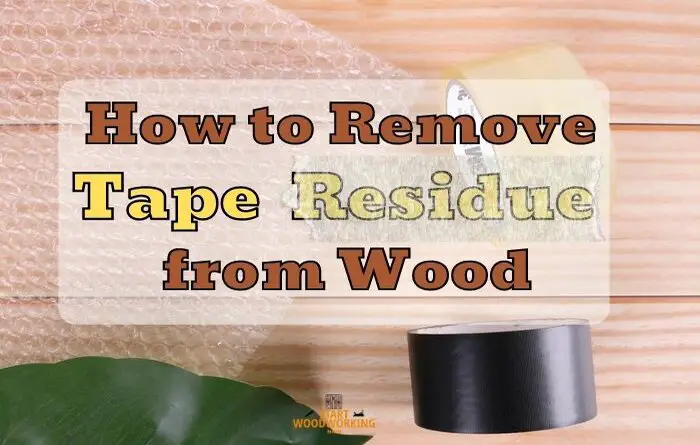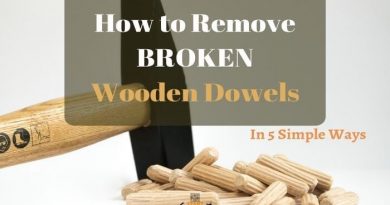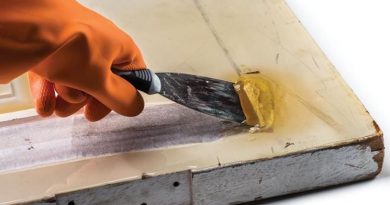Remove Tape Residue from Wood : [ In 9 Simple Ways ]
Is there a piece of duct tape residue that you can’t remove from your furniture? Adhesive tape is powerful, but it does leave a very sticky residue. Through this simple guide, you will be given useful information on how to remove tape residue from wood.
Steps:
- Gather a mild oil like olive, vegetable, or mineral oil along with a soft clean cloth or paper towel. Oils help dissolve adhesive without damaging wood.
- Apply a small amount of the oil directly onto the sticky tape residue. Thoroughly rub the oil over the entire area until saturated. The oil will help to loosen and dissolve the adhesive, making it easier to remove from wood.
- Let the oil soak for 10-15 minutes. This gives time for the oil to penetrate the tape residue and loosen its grip on the wood.
- Wipe away the softened residue with a clean section of the cloth. Check closely to ensure all residue is removed from the wood grain.
- For stubborn spots, reapply oil, let soak again, and wipe clean. For any remaining residue, you can repeat the process or gently scrape it off with a plastic scraper or credit card edge.
- Once the residue is removed, clean the oily area with a mild soap and water solution to remove any oil left on the wood surface, then dry with a clean cloth. Let the wood dry completely before finishing to prevent the recurrence of stickiness.
Household Methods for Removing Tape Residue
1. Oil-Based Solutions
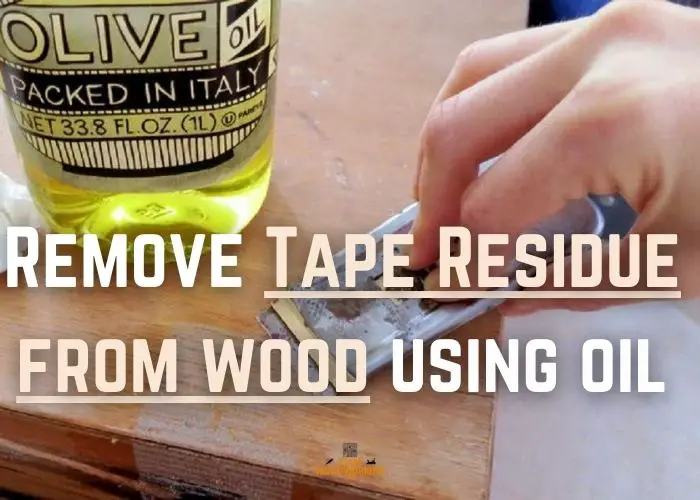
Gather your supplies. You will need a clean cloth or paper towel, olive oil or vegetable oil, and a plastic scraper or credit card.
Step 1: Determine the type of oil to use.
For light adhesive residue, I may try olive oil or coconut oil first as they can help break down the adhesive without being too harsh on the wood. Olive oil is perfect for dissolving adhesive residue from labels, stickers, and tape.
Other products also work as baby oil, peanut butter, and mayonnaise.
Step 2: Apply the oil directly to the sticky residue.
I would saturate a clean, soft cotton cloth with the chosen oil and rub it directly over the adhesive. The oil will start to break down the bond between the adhesive and the wood surface.
Leave the oiled paper towel in place for 2-3 hours. This allows time for the oil to fully saturate and soften the adhesive.
Step 3: Gently scrub the area with the oiled cloth.
While keeping the cloth saturated with oil, I would scrub in a circular motion over the sticky wood residue area. This action will help lift the now loosened adhesive from the wood pores.
I may need to re-saturate the cloth a few times to fully remove stubborn residue. Peanut butter can also work well to remove sticker glue if scrubbed in with an oiled cloth.
Dampen a clean cloth with warm, soapy water and wipe down the treated area. This will dissolve and pick up any lingering residue and oil.
Step 4: Wipe away the adhesive with a clean cloth.
Once the sticky residue has been broken down and scrubbed, I would wipe it away from the wood surface with a clean, dry cotton cloth. Multiple wipes may be needed to collect all adhesive remnants. Pouring a small amount of mineral oil directly on the adhesive can also help dissolve glue for easier removal.
Step 5: Reapply oil as needed.
If any sticky residue is still visible after wiping, I would reapply the chosen oil, let it soak in again, then scrub and wipe once more. Consistently reapplying oil will help fully remove even stubborn adhesive residue from wood.
For any stubborn residue that remains, use your plastic scraper or credit card to gently scrape it off, wiping the scraper clean frequently. Go with the wood grain direction to avoid scratching.
Be careful around absorbent materials like rugs and clothing because oil can stain. If this worries you, use a paste made with baking soda.
Pros of Using Oil-Based Solutions:
- Natural and often food-safe oils are gentle on wood finishes
- Oils dissolve adhesive bonds without harsh chemicals
- Often effective for softening many tape adhesives
- Allows residue to be massaged off with rag after soaking
- Relatively inexpensive and accessible ingredients
- Safe for raw wood and avoids damage from scraping
Cons of Using Oil-Based Solutions:
- Requires letting the oil soak for 10-15 minutes
- May need repeated applications for stubborn adhesives
- Results can be messy with excess oil on the surface
- Oil could leave stains or residue in wood grain
- Not as effective on some heavy-duty tapes
- Food oils can go rancid if left to soak too long
2. Rubbing Alcohol
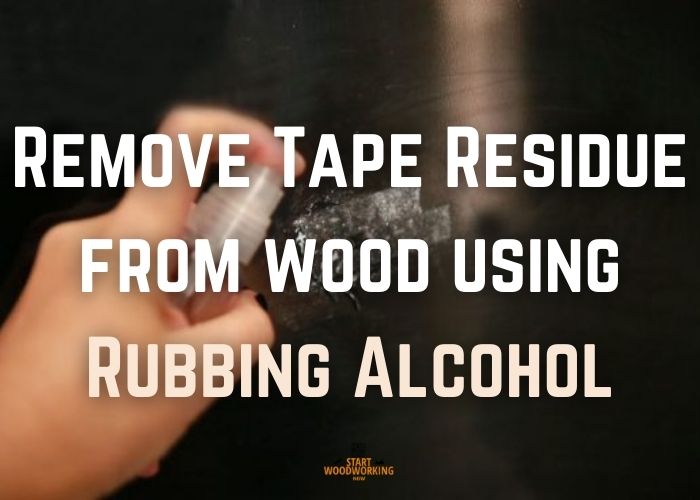
Step 1: Gather supplies.
I will need 91% isopropyl rubbing alcohol, which can be found at any drugstore, along with some clean cotton rags or balls. Rubbing alcohol is a great solvent for breaking down many adhesives and will work well to remove tape residue from wood.
Step 2: Saturate the cotton with alcohol.
Ethyl, ammonia, or methyl alcohol, as well as alcohol-containing compounds, will work effectively in removing tape residue from wood.
I will pour some rubbing alcohol onto a cotton rag or balls and thoroughly saturate the material. This will allow me to apply an even coat of the solvent directly to the sticky residue. Rubbing alcohol is safe to use on most untreated wood surfaces and won’t damage the material.
First, you just need to remove as much of the adhesive tape as you can by simply scraping it off with your fingernail.
Step 3: Apply the alcohol to the residue.
I will gently rub the soaked cotton directly over the tape marks, being sure to fully saturate the adhesive. The alcohol will start working immediately to break the bond between the glue and the wood fibers.
Step 4: Let it sit for 5 minutes.
I will allow the rubbing alcohol time to fully soak into the residue for 5 minutes. The solvent needs contact time to fully dissolve the adhesive compounds.
Step 5: Scrub and wipe.
After 5 minutes, I will scrub the wet cotton in a circular motion over the marks to help lift off the now-loosened residue. Multiple wipes with a clean, dry cloth will remove any remaining adhesive remnants from the wood surface.
Keep rubbing until the tape peels off the wood or you can get it off without any problems. Clean the wood with a cloth dampened with soapy water and dry with a towel.
Step 6: Dry completely
Allow the treated area to air dry fully before finishing. This prevents sticky residue from reappearing.
Pros of Using Rubbing Alcohol:
- Rubbing alcohol is readily available and inexpensive
- It quickly dissolves many tape adhesives on contact
- Evaporates quickly without leaving residue behind
- Safe for use on most finished and unfinished woods
- Can be applied directly onto residue and wiped clean
- More effective than water-based cleaners alone
Cons of Using Rubbing Alcohol:
- Rubbing alcohol can strip some wood finishes if overapplied
- Not as effective on some heavy duty adhesive tapes
- May require light sanding if residue remains in wood grain
- Can dry out wood over time, requiring re-oiling
- Gives off strong odor during application
3. Ice cubes
Step 1: Gather ice cubes and a plastic scraper.
I will need ice cubes (either from my freezer or purchased) as well as a plastic scraper or putty knife that won’t scratch the wood surface. Ice is very effective at making adhesive brittle so it can be easily scraped away.
You can also prepare ice cubes by filling an airtight ziplock bag with water and sealing it closed. Place it in the freezer until fully frozen.
Step 2: Apply the ice directly to the tape residue.
I will place a few ice cubes directly over the sticky tape marks. The cold temperature will start to harden the adhesive compounds. The ice causes the glue from the adhesive to contract and separate from the wood fibers.
Step 3: Let the ice sit for 5-10 minutes.
I will allow 5-10 minutes for the ice to thoroughly chill the residue. The adhesive needs time to become very firm and brittle from the freezing temperature.
Step 4: Scrape the adhesive residue while frozen.
Once chilled, I will gently scrape the adhesive away from the wood using the plastic scraper. Because the glue has hardened, it should flake off in small frozen pieces without damaging the wood.
Step 5: Repeat as needed.
If any residue remains, I will reapply fresh ice cubes and let sit before scraping again. Multiple applications may be needed for stubborn spots, but the ice makes removing adhesive clean and safe for the wood.
Step 6: Dry completely.
Let the cleaned area air dry fully before finishing. The ice method removes residue safely without harming delicate wood.
Pros of Using Ice Cubes:
- Ice is completely safe for all wood finishes and surfaces
- Provides a gentle cooling effect to harden and contract the adhesive
- No chemicals or mess involved
- Convenient and accessible from any freezer
- Can be applied directly to residue and left to sit
- Works for many common tapes like duct tape
Cons of Using Ice Cubes:
- Ice melting can make the process messy
- Not as effective on all heavy duty adhesive tapes
- Requires patience as it works slowly compared to solvents
- Ice must be reapplied as cubes melt to maintain cooling
- Could waterlog and damage raw wood if left too long
4. Warm Vinegar
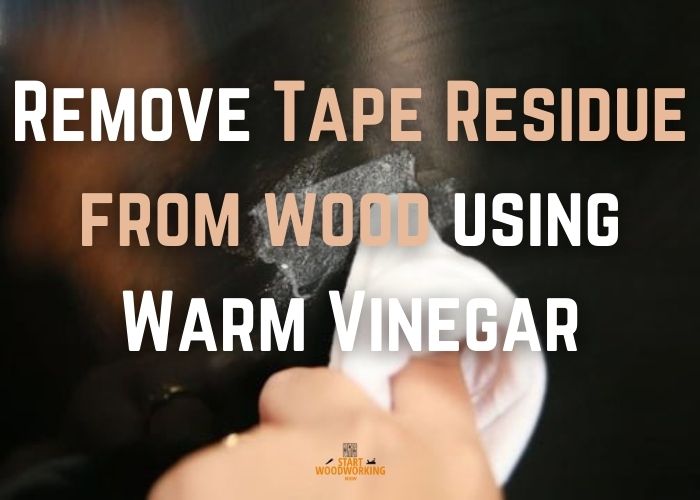
Step 1: Prepare the vinegar solution.
I will start by mixing 1 cup of white vinegar with 1 cup of warm (not hot) water in a small bucket or spray bottle. Alternatively, you can heat it in the microwave for 30 seconds until warm but not hot.
The warmth helps the vinegar penetrate the adhesive better. Vinegar is highly effective at breaking down many adhesives due to its acetic acid content.
Step 2: Apply the warm vinegar to the tape residue.
I will liberally apply the vinegar solution directly onto the sticky spots using a cloth or spray bottle. The acetic acid will immediately begin breaking the bond between the glue and wood fibers.
Step 3: Let it soak for 5-10 minutes.
I will allow the warm vinegar solution to soak into the residue for 5-10 minutes. This contact time allows the acetic acid to fully work its way into the adhesive compounds.
Step 4: Scrub the area gently.
After soaking, I will take a clean cloth or soft bristle brush and scrub the wet residue in small circular motions. This action helps lift the now-softened adhesive from the wood pores. Use a dry section of cloth to gently wipe the treated area. The residue should lift easily. Check for any remaining bits in the wood grain.
Step 5: Wipe and reapply as needed.
I will wipe away the residue with a dry cloth. If any marks remain, I can re-saturate with warm vinegar and repeat the process. With persistence, this method removes tape residue cleanly and naturally.
Pros of Using Warm Vinegar:
- Vinegar is very accessible and inexpensive
- Warm vinegar helps dissolve many adhesives
- Safer for wood than harsher chemicals
- Can be applied directly or with a soaked cloth
- Often effective for stubborn sticky residues
- Removes residue without heavy scraping
- Has a mild smell that dissipates as it dries
Cons of Using Warm Vinegar:
- Vinegar can damage some wood finishes with prolonged exposure
- Not as effective on some heavy duty tapes
- May need to reapply several times for thick residue
- Can raise wood grain if not wiped thoroughly
- Does not work as quickly as rubbing alcohol
5. Acetone
Before you use acetone, you should test in an inconspicuous place whether the wood reacts with the acetone.
Step 1: Gather supplies and protect the wood area.
I will need acetone, which can be found in nail polish remover, along with cotton balls or rags. I will also open windows and lay down drop cloths, as acetone vapors are strong. Acetone is one of the most effective solvents for dissolving adhesives. Acetone fumes are strong so open windows.
Step 2: Apply the acetone to the residue.
I will saturate a cotton ball with acetone and dab it directly onto the sticky wood spots. The acetone will immediately begin breaking down the adhesive compounds. Gently massage the soaked residue for 2-3 minutes. This allows the powerful acetone to penetrate deep into wood pores and dissolve adhesive bonds.
Step 3: Let it sit for 1-2 minutes.
I will allow 1-2 minutes for the acetone to fully penetrate the residue. Acetone works fast but needs brief contact time.
Step 4: Scrub the area gently.
After soaking, I will take another cotton ball or rag and scrub the wet residue in small circular motions. This lifts the softened adhesive from the wood.
Step 5: Wipe and check for remaining adhesive residue.
Using a dry cloth, I will wipe away the dissolved adhesive. I will inspect for any lingering marks and reapply acetone as needed to these spots. With its strong solvent properties, acetone is highly effective for removing tape residue from wood. I just need to take proper precautions with its fumes.
Step 6: Repeat as necessary
Stubborn residue may take additional acetone applications and wiping to remove completely.
Pros of Using Acetone:
- Acetone quickly dissolves and removes most tape adhesives
- Evaporates rapidly without leaving behind residue
- Can be applied directly to residue for fast removal
- Works on even thick, baked-on tape deposits
- Removes sticky residue from wood pores effectively
- Typically does not damage most wood finishes
Cons of Using Acetone:
- Acetone fumes are very strong and flammable
- Can melt or damage some plastics and finishes
- Should not be used on bare wood or it could discolor
- Repeated use can dry out wood over time
- Easy to overapply and damage wood surface
This step by step guide will show you how to remove grease from wood!
6. Liquid soap
Step 1: Gather supplies.
I will need a bottle of liquid dish or hand soap along with some warm water and clean cloths or a soft bristle brush. The surfactants in liquid soap can help break down many adhesive residues.
Step 2: Make a warm soapy solution.
I will mix a few drops of liquid soap into a bowl of warm water. The warmth helps the soap solution penetrate the adhesive better.
Step 3: Apply the soapy water to the residue.
Using a cloth or brush, I will liberally apply the warm soapy water directly onto the sticky spots. The soap will start breaking down the glue’s bonding properties.
Step 4: Let it sit briefly.
I’ll let the soapy solution sit for 2-3 minutes. This gives the soap time to loosen the adhesive’s grip on the wood fibers.
Step 5: Scrub and wipe away.
After letting it soak in, I’ll gently scrub the residue with the cloth or brush to lift it away. I’ll wipe clean with a fresh dry cloth.
Step 6: Repeat as needed for stubborn spots.
For any remaining sticky areas, I’ll reapply the warm soapy water and let sit before scrubbing again. With some persistence, the mild liquid soap can remove tape residue effectively while being very safe for finished and unfinished wood.
Pros of Using Liquid Soap:
- Liquid soap is very safe for all wood types and finishes
- Helps dissolve adhesive bonds with water and surfactants
- Very accessible and cost-effective ingredient
- Low odor and non-toxic for user
- Can be applied directly to residue and wiped clean
- Prevents need for harsh chemical solvents
- Good general surface cleaner along with residue removal
Cons of Using Liquid Soap:
- Not as effective on heavy-duty adhesive tapes
- Takes more scrubbing and rinsing to remove residue
- May require follow-up light sanding for complete removal
- Tape in wood pores may not be fully dissolved
- Need to avoid over-wetting raw wood surfaces
- Results take longer compared to chemical solvents
Do you want to easily remove gorilla glue from wood ? Follow this step by step tutorial I wrote!
Alternative Methods for Tape Residue Removal
1. Hair Dryer
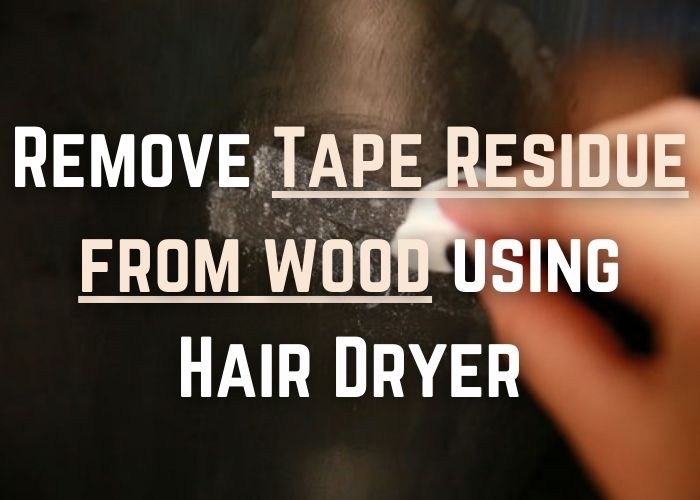
Adhesive residues can be warmed up with an iron or hairdryer. The effect is enhanced by applying additional fat to the heated area. With butter, mayonnaise, or cooking oil, the glue residues can be loosened even better and can be wiped off well after a short exposure time.
This method is well suited for painted, varnished coatings and furniture.
Step 1: Gather supplies.
I will need a hair dryer along with a plastic scraper or putty knife. The heat from the hair dryer can soften many adhesive residues, allowing them to be easily scraped off.
Step 2: Heat the residue with the hair dryer.
I start by setting a 1200+ watt hair dryer to medium heat and holding it a few inches above the wood’s surface near the tape residue. Holding the dryer 2-3 inches away, I will heat the area for 30-60 seconds.
Step 3: Test if the adhesive has softened.
Keeping the dryer on medium, I move it slowly back and forth over the residue for 2-3 minutes. This softens the adhesive glue. After heating, I’ll use the plastic scraper to gently test if the adhesive has softened.
If it easily flakes or scrapes away, it’s ready for removal. Heat causes the glue compounds to soften and loosen their bond with the wood.
Step 4: Scrape the residue away.
Keeping the heated area warm with the dryer, I’ll use the plastic scraper to gently lift and scrape away the softened adhesive. I’ll take care not to gouge the wood surface.
Once the residue is bubbled and gooey, I start at the edges and carefully lift the tape off with the spatula, working from the outside in.
If the residue is still firmly stuck, I increase the dryer to its highest heat setting and repeat the back-and-forth motion for another 2-3 minutes to further soften the adhesive. When the bulk of the tape is removed, I gently pull off any remaining bits by hand if possible.
Step 5: Repeat heating and scraping as needed.
For any leftover sticky areas, I’ll reapply hot air from the hair dryer and then scrape again. The key is keeping the residue warm during removal. With some patience, the hair dryer method can eliminate tape adhesive without chemicals.
I wipe the area with a microfiber cloth dampened with warm, soapy water to remove any leftover sticky residue.
If at any point I notice damage to the wood, I stop immediately and try an alternate method. Safety first!
The technique is good, but not applicable to surfaces for which heating is contraindicated. Before proceeding, however, it is necessary to examine the resistance of the wood: not all wood types, in fact, tolerate heat.
Among those not recommended mahogany, oak, and some lacquered. In case of doubt, therefore, it is necessary to carry out a test in a hidden corner of the wood surface.
Pros of Using Hair Dryer:
- Heat from the hair dryer softens and loosens the tape adhesive
- Allows residue to be more easily scraped off
- Quick and convenient using a common household item
- Helps evaporate any moisture from other cleaning methods
- Generally safe for use on most wood finishes
- Avoid chemicals solvents
Cons of Using Hair Dryer:
- Excessive heat can damage some wood finishes
- Less effective on thick or baked-on tape deposits
- Can spread adhesive deeper into wood grain
- Easy to overheat one section, requiring frequent movement
- Still requires scraping off the loosened adhesive
- Noisy and difficult to concentrate heat on small areas
- Not as effective for tape residue in wood pores
2. WD-40 and a Razor Blade
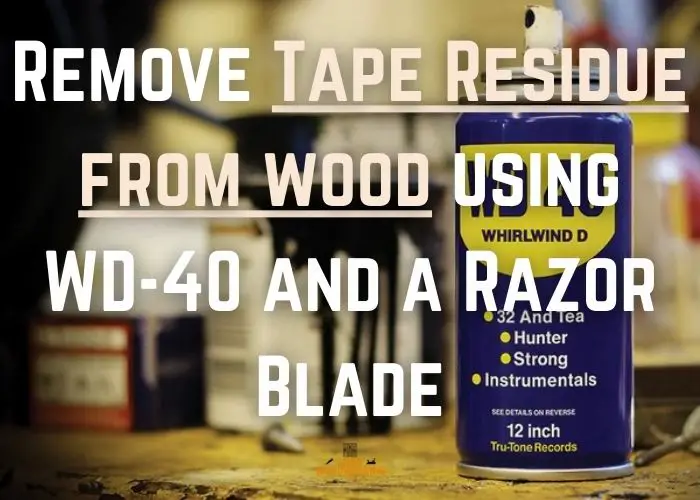
Step 1: Gather supplies.
I will need a can of WD-40, a new sharp razor blade, and some clean cloths. The lubricating properties of WD-40 combined with the scraping action of the blade can eliminate sticky tape marks.
Step 2: Apply WD-40 generously to the residue.
I will spray or wipe the WD-40 directly onto the adhesive, saturating the area. This helps loosen the glue’s grip on the wood fibers. WD-40 can dissolve many tape adhesives.
Step 3: Let it soak for 2-3 minutes.
I’ll give the WD-40 a few minutes to fully penetrate and break down the sticky residue before scraping. This dwell time is important for the solvent to work.
Step 4: Optionally, first try carefully scraping the tape with the razor blade before spraying WD-40 to see if it can be removed easily. Use shallow 2-4 degree angle along wood grain.
Step 5: Scrape in the direction of the wood grain.
I’ll brace one hand on the surface and use the razor blade to gently scrape along the wood grain, lifting off the softened glue. Applying pressure at a low angle prevents digging into the wood.
Step 6: Wipe clean and repeat as needed.
I’ll wipe away any excess WD-40 and residue with a clean cloth. For any leftover sticky spots, I’ll reapply WD-40 and scrape again. The blade allows precise removal.
Step 7: For the final thin glue layer, wipe firmly with a soft cloth. The WD-40 breaks down the adhesive bonds.
Pros of WD-40 and a Razor Blade:
- WD-40 dissolves adhesive bonds and allows residue to scrape off
- A razor blade can scrape off residue easily after WD-40 applied
- WD-40 penetrates and lifts residue from wood pores
- Allows precise scraping control with a razor blade
- Effectively removes even thick tape buildup
- WD-40 helps prevent razor blade from damaging wood
Cons of WD-40 and a Razor Blade:
- WD-40 can damage some wood stains and finishes
- Razor blades require extremely careful handling on wood
- Potential for deep gouges or scratches if razor slips
- Not as effective on extremely stubborn adhesives
- Razor may dull quickly if tape residue is thick
- Overspray of WD-40 spreads oily residue on surface
You can also remove crayon marks from wood using WD-40. Here are the step you need to follow!
3. White Spirit
Step 1: Gather supplies.
I will need a bottle of white spirit, some clean cloths, and a plastic paint scraper or putty knife. White spirit can dissolve many common adhesives.
Step 2: Apply white spirit to the residue.
Using a cloth, I will liberally apply the white spirit directly onto the sticky tape marks on the wood. This helps soften the adhesive.
Step 3: Let it soak for 2-3 minutes.
I'll give the white spirit a few minutes to fully penetrate and break down the glue residue before scraping. This dwell time allows it to work.
Step 4: Gently scrape with the plastic scraper.
I'll use the scraper to lightly lift and scrape away the softened adhesive, taking care not to dig into the wood finish.
Step 5: Wipe clean and repeat as needed.
I'll wipe away any excess white spirit and residue with a clean cloth. For any leftover sticky areas, I'll reapply white spirit and scrape again.
Step 6: Rinse with water and dry.
Once all residue is removed, I'll rinse the area with clean water on a damp cloth to remove any remaining white spirit. I'll dry it immediately with a paper towel.
Step 7: Dry and polish
Finally, I allow the wood to fully dry and buff it with polish or wax to restore its natural luster.
It is extremely important to perform all actions as quickly as possible so that the product does not dissolve the polishing itself. This rule also applies to the processing of painted products.
Pros of using White Spirit:
- White spirit effectively dissolves and removes many adhesives
- Evaporates fast without leaving an oily residue
- Can be applied directly to residue and wiped clean
- Helps remove stubborn sticky deposits from pores
- Typically safe for using on most finishes and stains
- Fast-acting compared to weaker solvents
- Very effective at removing residue from sanding
Cons of using White Spirit:
- White spirit fumes are strong and flammable
- Can damage some sensitive finishes if overapplied
- Repeated use can dry out and discolor raw wood over time
- Some plastic parts and tapes are not compatible
- Does not work as well on some vinyl and foil tapes
- Can spread adhesive deeper into wood grain if overused
Remove Duct Tape from a Wooden Door
Step 1: Use a blunt knife to scrape off the tape off your wooden door. Use the straight edge to avoid scratching the door.
Step 2: Blow hot air over the remaining adhesive materials to loosen them further. Use a dry sponge to remove the adhesive without scratching the door.
Step 3: Use a deep stain remover to get rid of the remaining chunks. There are several commercial products available designed to remove deep stains or sticky material from walls or doors.
Letting it soak for 5-10 minutes gives the solution time to penetrate and loosen the adhesive bonds. Don't let it sit too long or it could damage the finish.
Use a plastic scraper, credit card, or wood scraper. Avoid metal scrapers or abrasives that could scratch the wood. Work carefully to lift residue without damaging the surface.
Very stubborn adhesive may require sanding and refinishing the wood to fully remove it. Test an inconspicuous spot first before sanding the entire surface. Seek professional help for valuable wood.
After scraping, wipe the area with a solvent like mineral spirits using a clean rag. For soap solutions, wipe clean with a damp microfiber cloth.

